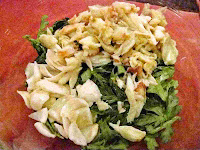<Ingredients>
150 g crabmeat
30-40 g shungiku garland chrysanthemum (leaves only; small handful/bunch with stems)
15 yurine lily bulb scales (dried yurine soaked overnight)
Flour (to dust ingredients; not in photo)
For tempura batter
6 tbsp flour
2 tbsp potato starch
1/4-1/2 egg
120cc cold water
Pinch salt (not in photo)
Oil for deep-frying (canola oil, or canola and 10-15% sesame oil mixture; not in photo)
Tentsuyu tempura dipping sauce (for serving; not in photo)
10cm daikon radish (grated for serving; not in photo)
<Directions>
1.
Start to heat oil to 355 F/180 C.
2.
Chop shungiku into 2-3 cm.
Remove discolored parts of yurine, and roughly chop.
Place crabmeat, shungiku and yurine in a bowl, and dust with flour.
3.
In another bowl, put flour, potato starch and salt, and mix well.
Mix egg and cold water.
Pour egg-water mixture in the flour mixture, and quickly and roughly mix.
Flour and liquid do not need to be fully incorporated.
4.
When oil is ready (fine bubbles come up relatively vigorously from tips of bamboo chopsticks [oil temperature is not quite high enough in the photo at left], or batter quickly sinks for 1-2 seconds and comes back to the surface), put crabmeat, shungiku and yurine for 1 kakiage piece in the utensil, mix with batter in a corner.
Tilt utensil to get rid of excess batter, and gently put into oil.
When bottom side becomes crispy, flip.
Immediately raise heat somewhat.
Cook until both sides are crispy, lift tempura with one end still immersed in oil to draw it back into the pot, and remove while quickly shaking off excess oil; place on a plate or tray lined with paper towel.
5.
Serve hot with tentsuyu and grated daikon.
<Notes>
- Dusting ingredients with flour first helps to keep each kakiage piece intact. Otherwise, they tend to scatter in oil.
- Adding potato starch to tempura batter helps to prevent formation of excessive gluten and makes the texture light at the end. Corn starch or rice flour can substitute for potato starch.
- Always keep all ingredients cold, especially batter, to ensure a crispy and light tempura outcome.
- If you put all goodies in the batter, only the first few would be very crispy due to formation of gluten while selecting or moving ingredients in the batter to get a good mix for each kakiage piece. For this reason, when making more than a few kakiage pieces and trying to get a good mix of ingredients (especially a mix of soft and firm goodies), working on each kakiage piece gives better results.
- Because crabmeat is pre-cooked, and both shungiku and yurine cook very fast, each kakiage piece is done in a short time (90 seconds or so? I’ve never timed this). Keep oil temperature high (higher than deep-frying root vegetables, for example) for a crispy outcome.
- If tentsuyu is not available, dilute soy sauce with dashi or water.
- Grated daikon helps with digestion of oil.
- You can get 220-240 g of crabmeat from 1 medium-size Dungeness crab.


















No comments:
Post a Comment